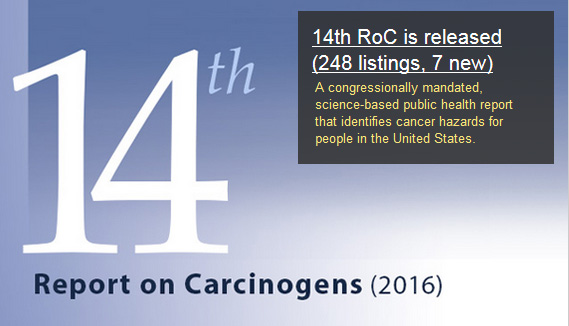

By Mary Jane Dittmar
The Report on Carcinogens, 14th Edition, is prepared by the National Toxicology Program (NTP). NTP is a federal, interagency program, headquartered at the U.D. Department of Health’s National Institute of Environmental Health Science (NIEHS), whose goal is to safeguard the public by identifying substances in the environment that may affect human health The U.S. Department of Health and Human Services (HHS) has added seven substances to its Report of Carcinogens. The new elements include a chemical, cobalt, and five viruses.
Trichloroethylene (TCE)
TCE, an industrial solvent, is used primarily to make hydrofluorocarbon chemicals. Listed as “a reasonably anticipated human carcinogen” since 2000, it is now classified in the 14th Report on Carcinogens as a known human carcinogen. Numerous human studies have shown a causal association between exposure to TCE and an increased risk for kidney cancer. TCE, used as a metal degreasing agent for military equipment, can be released into the air, water, and soil at places where it is produced or used. It can move readily through soil and into underground drinking water sources. It has been found in the groundwater at many military and Superfund sites.
Cobalt and Cobalt Compounds That Release Cobalt Ions in Vivo (in a living organism)
They are being listed as “reasonably anticipated to be a human carcinogen.” The listing includes different types of cobalt compounds that release ions into the body. Cobalt, a naturally occurring element, is used to make metal alloys and other metal compounds, such as military and industrial equipment, and rechargeable batteries. The highest exposure occurs in the workplace and from failed surgical implants. The listing for this metal and its compounds is based largely on studies in experimental animals.
Viruses Linked to Cancer
HHS stresses that a listing in the report indicates a cancer hazard, but it does not by itself mean that a substance or a virus will cause cancer. Other factors, including a person’s susceptibility to the substance and the amount and duration of the exposure, can affect whether a person will develop cancer. In the case of viruses, a weakened immune system may also be a contributing factor. People should talk to their health care providers about decreasing their cancer risk from viruses.
The five viruses are listed in the “known to be a human carcinogen” category. These fives viruses collectively have been linked to more than 20 different types of cancers.
- Human immunodeficiency virus type 1 (HIV-1) is spread through unprotected sexual activity, infected drug needles, during pregnancy from mother to child, and through infected breast milk. The HIV virus attacks the body’s immune system, and thus causes AIDS.
- Human T-cell lymphotropic virus type 1 (HTLV-1) is a virus that people are exposed to through contact with contaminated cells or biological tissues such as through breastfeeding, sharing of needles or syringes with infected individuals, or unprotected sexual activity. It is not transmitted by casual contact.
- Epstein-Barr virus (EBV) is a herpesvirus transmitted primarily through saliva. It is a common virus that infects more than 90 percent of adults worldwide. Most people infected with EBV remain healthy and without symptoms. In some cases, EBV can cause infectious mononucleosis, also called mono.
- Kaposi sarcoma-associated herpesvirus (KSHV) is a herpesvirus that is transmitted from person to person, primarily through saliva. It can be transmitted through sexual contact (primarily among homosexual men), through blood, and from an infected mother to a child. Healthy individuals can be infected with the virus and show no signs or symptoms.
- Merkel cell polyomavirus (MCV) is a common virus that lives on the skin; it rarely produces symptoms or leads to cancer. Exposure may occur through close personal contact with the saliva or skin of an infected individual. Human epidemiology studies in populations in different geographic locations as well as clinical and molecular studies show that Merkel cell polyomavirus causes Merkel cell carcinoma.
The Report on Carcinogens is a congressionally mandated report. The new report is available HERE
 Mary Jane Dittmar is senior associate editor of Fire Engineering and conference manager of FDIC. Before joining the magazine in January 1991, she served as editor of a trade magazine in the health/nutrition market and held various positions in the educational and medical advertising fields. She has a bachelor’s degree in English/journalism and a master’s degree in communications.
Mary Jane Dittmar is senior associate editor of Fire Engineering and conference manager of FDIC. Before joining the magazine in January 1991, she served as editor of a trade magazine in the health/nutrition market and held various positions in the educational and medical advertising fields. She has a bachelor’s degree in English/journalism and a master’s degree in communications.

